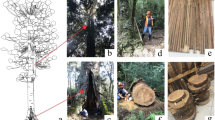Abstract
Simple distribution models (SDMs) have deficiencies in portraying irregular forest diameter structure. This paper introduces mixture distribution models (MDMs) to improve the estimation accuracy of stand volume of Siberian larch (Larix sibirica Ledeb.) forests. Stand volume was estimated by combining the suitable diameter mixture model and diameter–height model. Appropriate mixture models are derived by integrating multiple SDMs of Burr III and XII, Johnson SB, Weibull or lognormal probability density functions (pdf) that satisfied the criteria of goodness of fit tests. Results showed that the average bias of volume estimation for all of the study plots using SDM and MDM approaches are underestimated by 6.93 and 2.42 m3, respectively. Each of the estimates is equivalent to an estimation error of 25.59 ± 18.18 and 7.08 ± 2.97 %. This suggests that the MDM approach is a more flexible and suitable modeling technique for forest volume estimation, in particular for forests that have been frequently disturbed by natural events.


Similar content being viewed by others
Abbreviations
- dbh:
-
Tree diameter at breast height
- h :
-
Tree height
- SDM:
-
Simple distribution model/modeling
- MDM:
-
Mixture distribution model/modeling
- pdf:
-
Probability density function
- K–S:
-
Kolmogorov–Smirnov test
- A–D:
-
Anderson–Darling test
- χ 2 :
-
Chi-square test
- volT :
-
Total volume of a plot
- evolT :
-
Estimates of volT
- mvolT :
-
Measured volT
References
Bailey RL, Dell TR (1973) Quantifying diameter distribution with the Weibull-function. For Sci 19:97–104
Burr IW (1942) Cumulative frequency functions. Ann Math Stat 13:215–232
Curtis RO (1967) Height-diameter and height-diameter-age equations for second-growth Douglas-fir. For Sci 13:365–375
D’Agostino RB, Stephens MA (1986) Goodness-of-fit techniques. Marcel Dekker, New York
Dorado FC, Diéguez-Aranda U, Barrio MA, Rodríguez MS, von Gadow K (2006) A generalized height and diameter model including random components for radiata pine plantations in northwestern Spain. For Ecol Manag 229:202–213
Fang Z, Bailey RL (1998) Height–diameter models for tropical forests on Hainan Island in Southern China. For Ecol Manag 110:315–327
Gove JH, Ducey MJ, Leak WB, Zhang L (2008) Rotated sigmoid structures in managed uneven-aged northern hardwood stands: a look at the Burr Type III distribution. Forestry 81:161–176
Hafley WL, Schreuder HT (1977) Statistical distributions for fitting diameter and height data in even-aged stands. Can J For Res 7:481–487
Hamilton F, Brack CL (1999) Stand volume estimates from modelling inventory data. Aust For 62:360–367
Huang DS, Price D, Titus SJ (2000) Development of ecoregion-based height–diameter models for white spruce in boreal forests. For Ecol Manag 129:125–141
Jaworski A, Podlaski R (2012) Modelling irregular and multimodal tree diameter distributions by finite mixture models: an approach to stand structure characterisation. J For Res 17:79–88
Johnson NL (1949) Systems of frequency curves generated by methods of translation. Biometrika 36:149–176
Larsen DR, Hann DW (1987) Height-diameter equations for seventeen tree species in southwest Oregon. Research paper 49, Forest research lab, Oregon State University, Corvallis
Lin C, Chan MH, Chen FS, Wang YN (2007) Age structure and growth pattern of an endangered species, Amentotaxus formosana Li. J Integr Plant Biol 49:157–167
Lindsay SR, Wood GR, Woollons RC (1996a) Stand table modelling through the Weibull distribution and usage of skewness information. For Ecol Manag 81:19–23
Lindsay SR, Wood GR, Woollons RC (1996b) Modelling the diameter distribution of forest stands using the Burr distribution. J Appl Stat 23:609–619
Podlaski R (2010a) Two-component mixture models for diameter distributions in mixed-species, two-age cohort stands. For Sci 56:379–390
Podlaski R (2010b) Diversity of patch structure in Central European forests: are tree diameter distributions in near-natural multilayered Abies-Fagus stands heterogeneous? Ecol Res 25:599–608
Rennolls K, Wang M (2005) A new parameterization of Johnson’s SB distribution with application to fitting forest tree diameter data. Can J For Res 35:575–579
Rodriguez RN (1977) A guide to the Burr type XII distributions. Biometrika 64:129–134
Semechkin IW, Tetenkin AE (1980) Northern Mongolian forest structure characteristic. Mongolian For Bull V 12:66–116 (in Russian)
Tadikamalla PR (1980) A look at the Burr and related distributions. Int Stat Rev 48:337–344
Tsogt Z, Danilin IM, Naurzbaev MM (2009) Course of the growth of larch forests in Mongolia. In: Ecological-geographical aspects of the forest process: All Russian conference with the participation of foreign scientists. Krasnoyarsk, 23–25 September 2009. V.N.Sukachev Institute of Forest of SB RAS. pp 173–178 (in Russian)
Wiant HV Jr, Wood GB, Miles JA (1989) Estimating the volume of a radiata pine stand using importance sampling. Aust For 52:286–292
Wykoff WR, Crookston NL (1982) Stage AR. User’s guide to the stand prognosis model. USDA For Serv Gen Tech Rep INT-133
Zhang L, Liu C (2006) Fitting irregular diameter distributions of forest stands by Weibull, modified Weibull, and mixture Weibull models. J For Res 11:369–372
Zimmer WJ, Burr IW (1963) Variables sampling plans based on non-normal populations. Industrial Quality Control. pp 18–36
Acknowledgments
This work was supported in part by the Forestry Bureau in Taiwan under Grant 100AS-8.3.3-FM-e1. Prof. Tsogt Zandraabal, who is with the Institute of Botany, Mongolia Academy of Sciences, is highly appreciated for his kind assistance in dealing with the ground survey of this study.
Author information
Authors and Affiliations
Corresponding author
About this article
Cite this article
Tsogt, K., Lin, C. A flexible modeling of irregular diameter structure for the volume estimation of forest stands. J For Res 19, 1–11 (2014). https://doi.org/10.1007/s10310-012-0380-z
Received:
Accepted:
Published:
Issue Date:
DOI: https://doi.org/10.1007/s10310-012-0380-z




